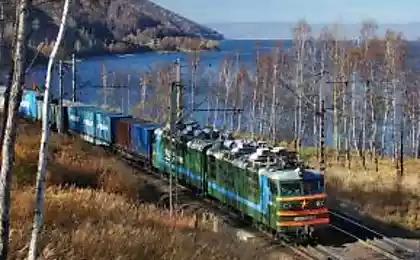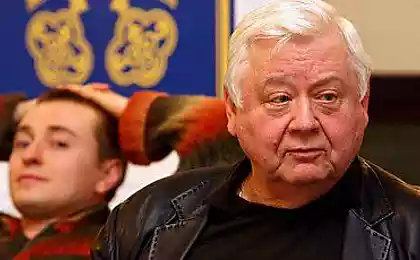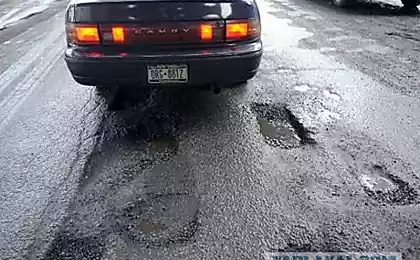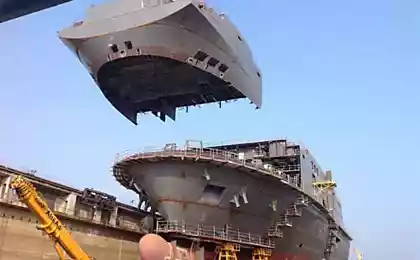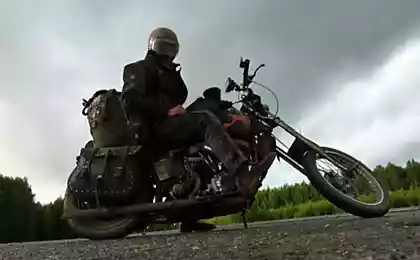723
Why the bad roads in Russia ?!
As is known in Russia two troubles. And if the first decision can wait a little longer, then the solution "road" issue has prolonged any longer. According to the rating of the World Economic Forum, Russia is "honorable" in the ranking of 130 out of 142 countries. Better than in Russia, the roads in countries such as Angola, Kyrgyzstan and Tajikistan.
Let's see what the problem lies and why our roads are more like direction. One of the main claims to the Russian roads - a rut and dips (pit). For these two reasons, it reduced most of the claims. Thaw that is happening on the roads in northern regions during the offseason - a vile thing, but for the majority of the population still invisible
But what is the rut and failures in terms of the processes taking place in the way?
The road - a complex infrastructure facilities, consisting of several layers.
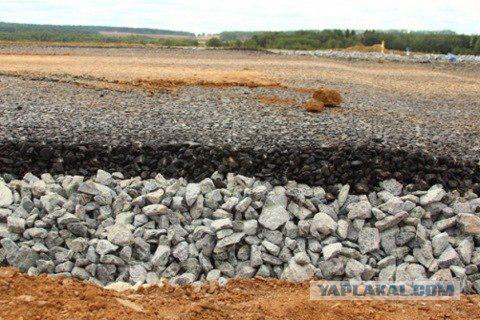
The road - a complex infrastructure facilities, consisting of several layers
The bottom layer - a layer of foundation - soil, the next layer - sand, gravel, and then goes past the top layer - pavement - or asphalt. When broken asphalt, there are cracks and small holes in the road that prevent mobility, but, as they say, "is not fatal." But when moving the base when the rubble away in the sand, and the sand is mixed with the soil, that's when and begin the processes that lead to the result to a track height of tens of centimeters, failing which at the speed the car turns a wheel, broken suspension, and sometimes occur more serious accident.
It would seem that everything is simple and logical and is on the surface, you just have to figure out how to reinforce the foundation and this will solve all the problems. In the Soviet Union found a solution to this issue: rude and expensive - began to use in the construction of concrete slabs that addresses the issue, but at what cost? Unfortunately, such a construction could not afford the Soviet Union, but Russia in the 90s with the indiscriminate construction of underfunding in all directions.

Bad roads - the cause of serious accidents
In the modern world you need to be frugal, to be competitive, that is, to build a lot of good roads, they do not have to be expensive. This simple conclusion was made a long time, all developed countries that do not have huge oil and gas reserves that got them "for free". In this regard, they have to "count the money." These developed countries and come up with materials that can enhance the quality and length of service roads, slightly (1%), increasing the cost of road during construction. Due to this, during the first 20-30 years, there is significant cost savings on maintenance and repairs (up to 15-20% of the total cost of repairs during construction without Geomaterials).
What did come up with? In the 70s of the 20th century invented a needle geotextile (in the USSR, he was called "Dornit"). This material was used in contact with the soil and sand does not allow these layers to mix, in addition to the geotextile used draining properties, i.e. he was able to withdraw water from the roadway.

Bonded geotextiles
At the time, it was a breakthrough for our technology stuff, it seemed that it solves the problem of substandard roads once and for all. But over time, the load on the roads has increased and the use of geotextiles has become insufficient. At this point in the world there is a new building material - flat plastic geogrid. This material has been used between the layers of sand and gravel. It uses the effect of "jamming and recording." Ie rubble, getting into the cell of the lattice, pressed, and under the pressure created by the layer with the new features, which can be figuratively called "psevdobetonnaya plate." This layer is much less sensitive to dynamic loads in different planes.

"Psevdobetonnaya plate»
It is logical that such materials obtained in developed countries widespread. For example, in Canada (the country with similar climatic conditions to Russia) geotextile is used by more than 90% of federal roads, geogrid - more than 60%. In the US, a similar picture. In Germany, almost 100% of all the roads built using geotextile and more than 80% of the roads with the additional reinforcement geogrid. In the last decade, its infrastructure started to actively develop China, and there is also actively used geomaterials.
Posted in [mergetime] 1354218740 [/ mergetime]
Roads in China
How about Russia? In 2011, in the Russian Federation on federal roads 1 and 2 categories of geotextiles used less than 50% of cases, and the flat geogrid - less than 10% of cases! Experts believe that the main reason for such a rare use of modern materials - badly outdated regulatory framework. In fact, we continue to build roads on technologies of the last century.
Who produces geosynthetics in Russia? Manufacturers of geotextiles in Russia a lot, but unfortunately, most manufacturers do not reflect on the quality of products, producing the cheap stuff from secondary, already once processed raw materials. This is roughly the same as that used to use the old nails: nail like the same, but already bent and broken, and that the worst thing is not so hold.
Posted in [mergetime] 1354218882 [/ mergetime]
All end
P.S.
About CORUPTION theft and even writing is so clear !!!
Here you can still discuss the qualifications of workers


Source:
Let's see what the problem lies and why our roads are more like direction. One of the main claims to the Russian roads - a rut and dips (pit). For these two reasons, it reduced most of the claims. Thaw that is happening on the roads in northern regions during the offseason - a vile thing, but for the majority of the population still invisible
But what is the rut and failures in terms of the processes taking place in the way?
The road - a complex infrastructure facilities, consisting of several layers.

The road - a complex infrastructure facilities, consisting of several layers
The bottom layer - a layer of foundation - soil, the next layer - sand, gravel, and then goes past the top layer - pavement - or asphalt. When broken asphalt, there are cracks and small holes in the road that prevent mobility, but, as they say, "is not fatal." But when moving the base when the rubble away in the sand, and the sand is mixed with the soil, that's when and begin the processes that lead to the result to a track height of tens of centimeters, failing which at the speed the car turns a wheel, broken suspension, and sometimes occur more serious accident.
It would seem that everything is simple and logical and is on the surface, you just have to figure out how to reinforce the foundation and this will solve all the problems. In the Soviet Union found a solution to this issue: rude and expensive - began to use in the construction of concrete slabs that addresses the issue, but at what cost? Unfortunately, such a construction could not afford the Soviet Union, but Russia in the 90s with the indiscriminate construction of underfunding in all directions.

Bad roads - the cause of serious accidents
In the modern world you need to be frugal, to be competitive, that is, to build a lot of good roads, they do not have to be expensive. This simple conclusion was made a long time, all developed countries that do not have huge oil and gas reserves that got them "for free". In this regard, they have to "count the money." These developed countries and come up with materials that can enhance the quality and length of service roads, slightly (1%), increasing the cost of road during construction. Due to this, during the first 20-30 years, there is significant cost savings on maintenance and repairs (up to 15-20% of the total cost of repairs during construction without Geomaterials).
What did come up with? In the 70s of the 20th century invented a needle geotextile (in the USSR, he was called "Dornit"). This material was used in contact with the soil and sand does not allow these layers to mix, in addition to the geotextile used draining properties, i.e. he was able to withdraw water from the roadway.

Bonded geotextiles
At the time, it was a breakthrough for our technology stuff, it seemed that it solves the problem of substandard roads once and for all. But over time, the load on the roads has increased and the use of geotextiles has become insufficient. At this point in the world there is a new building material - flat plastic geogrid. This material has been used between the layers of sand and gravel. It uses the effect of "jamming and recording." Ie rubble, getting into the cell of the lattice, pressed, and under the pressure created by the layer with the new features, which can be figuratively called "psevdobetonnaya plate." This layer is much less sensitive to dynamic loads in different planes.

"Psevdobetonnaya plate»
It is logical that such materials obtained in developed countries widespread. For example, in Canada (the country with similar climatic conditions to Russia) geotextile is used by more than 90% of federal roads, geogrid - more than 60%. In the US, a similar picture. In Germany, almost 100% of all the roads built using geotextile and more than 80% of the roads with the additional reinforcement geogrid. In the last decade, its infrastructure started to actively develop China, and there is also actively used geomaterials.
Posted in [mergetime] 1354218740 [/ mergetime]
Roads in China
How about Russia? In 2011, in the Russian Federation on federal roads 1 and 2 categories of geotextiles used less than 50% of cases, and the flat geogrid - less than 10% of cases! Experts believe that the main reason for such a rare use of modern materials - badly outdated regulatory framework. In fact, we continue to build roads on technologies of the last century.
Who produces geosynthetics in Russia? Manufacturers of geotextiles in Russia a lot, but unfortunately, most manufacturers do not reflect on the quality of products, producing the cheap stuff from secondary, already once processed raw materials. This is roughly the same as that used to use the old nails: nail like the same, but already bent and broken, and that the worst thing is not so hold.
Posted in [mergetime] 1354218882 [/ mergetime]
All end
P.S.
About CORUPTION theft and even writing is so clear !!!
Here you can still discuss the qualifications of workers



Source:





